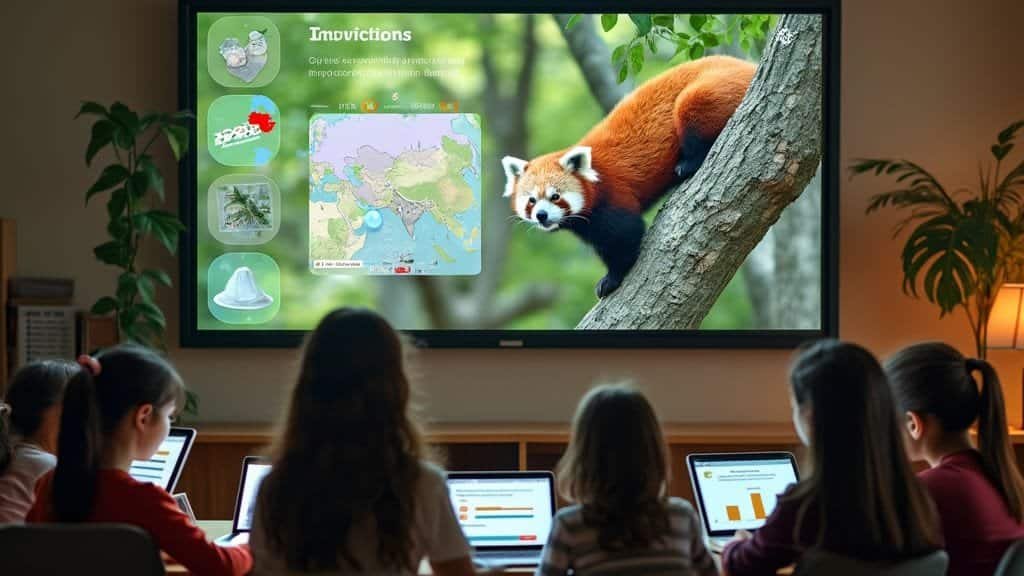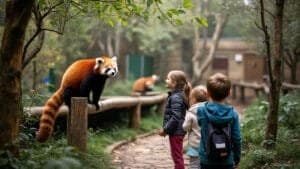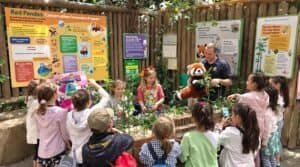Introduction
Virtual learning platforms have become powerful tools for educating students about wildlife conservation, including the protection of endangered species like red pandas
These platforms combine interactive tools, videos, virtual tours, and engaging activities to help students learn about red panda habitats, behavior, and conservation challenges. By collaborating with zoos and conservation experts, these platforms offer comprehensive lessons that teach students about environmental issues and the importance of preserving ecosystems
In this article, we will explore how virtual learning platforms use innovative methods to engage students in red panda education and inspire action toward wildlife conservation
How Virtual Platforms Teach About Red Pandas
Virtual learning platforms have revolutionized how students learn about red pandas and wildlife conservation. By offering a combination of interactive tools, multimedia resources, and engaging activities, these platforms make learning both accessible and immersive
The use of technology allows students to explore the lives of red pandas, their habitats, and the critical conservation efforts aimed at protecting them
Interactive Tools for Red Panda Education
One of the key features of virtual learning platforms is the use of interactive tools, such as 3D models, simulations, and clickable maps, to teach students about red pandas
These tools allow students to virtually “explore” the red panda’s natural habitat, learn about their diet and behavior, and understand the environmental challenges they face. For instance, students can interact with a digital model of a red panda’s ecosystem, learning how factors like deforestation and climate change impact their survival
Platforms often include quizzes, drag-and-drop activities, and puzzles where students can piece together the components of a red panda’s habitat or lifecycle. These interactive exercises keep students engaged while helping them retain information about conservation concepts
For younger students, animated storybooks featuring red pandas provide an engaging way to introduce basic environmental ideas and foster an emotional connection to the animal
Using Videos and Virtual Tours for Immersive Learning
Many virtual platforms also rely on videos and virtual tours to give students a more immersive experience. Through narrated videos, students can watch red pandas in their natural environment, observing their behaviors such as climbing, foraging, and interacting with their surroundings
These visual elements bring the red panda’s world to life, making it easier for students to understand how these animals live and why they are endangered
Virtual tours of zoos and wildlife sanctuaries further enhance the learning experience. Platforms like Google Expeditions and National Geographic offer virtual reality (VR) experiences where students can “visit” a red panda’s enclosure or follow wildlife conservationists as they track and monitor red pandas in the wild
These VR experiences provide a first-hand view of what conservation efforts look like, helping students feel more connected to the cause
Virtual Quizzes and Games to Reinforce Conservation Knowledge
To reinforce the concepts taught through videos and interactive tools, virtual platforms often use quizzes and educational games that challenge students to apply what they have learned
For example, students might take a quiz on red panda facts or play a game that simulates the challenges red pandas face in the wild, such as finding food, avoiding predators, or navigating shrinking habitats due to deforestation
These games often reward students for completing conservation-related tasks, encouraging them to think critically about solutions to environmental problems. By gamifying the learning process, platforms make education fun and engaging while emphasizing the importance of conservation efforts
The goal is to leave students not just with knowledge, but with a sense of responsibility for protecting species like the red panda
Wildlife Conservation Lessons on Virtual Learning Platforms
Virtual learning platforms are designed to provide comprehensive lessons on wildlife conservation, with a specific focus on endangered species like the red panda
These platforms integrate multimedia resources and interactive content to teach students about the threats facing red pandas and the importance of protecting their habitats
By incorporating expert knowledge and collaborations with conservation organizations, these lessons offer students a deeper understanding of the broader environmental context surrounding red panda conservation
Focus on Red Panda Habitat and Ecosystem Preservation
A central theme in red panda conservation lessons is the preservation of their natural habitat, which is crucial for their survival. Virtual platforms often include lessons that focus on the specific ecosystems red pandas inhabit—temperate forests in the eastern Himalayas and southwestern China
Through interactive maps, videos, and detailed descriptions, students can learn about the biodiversity of these regions and the role red pandas play in maintaining ecological balance
These lessons highlight the environmental factors that threaten red panda habitats, such as deforestation, climate change, and human encroachment. By understanding how these factors affect red pandas and other species in the ecosystem, students gain a broader perspective on the importance of preserving natural habitats
Virtual platforms also explore solutions to these problems, such as sustainable forestry practices, reforestation efforts, and habitat protection laws
Teaching Conservation Issues and Solutions
In addition to habitat preservation, virtual platforms teach students about the specific conservation issues red pandas face, including poaching, illegal wildlife trade, and the impacts of climate change
Lessons often include case studies or real-world examples of how these issues have affected red panda populations, providing students with concrete examples of the challenges conservationists must overcome
Students also learn about the various strategies being implemented to protect red pandas, such as breeding programs, anti-poaching initiatives, and efforts to curb illegal wildlife trafficking. Some platforms encourage students to brainstorm their own solutions to these conservation problems, fostering critical thinking and problem-solving skills
This approach not only educates students about the threats to red pandas but also empowers them to think about how they can contribute to conservation efforts
Collaborations with Zoos and Conservation Experts
Many virtual learning platforms partner with zoos, wildlife sanctuaries, and conservation organizations to provide expert-led lessons on red panda conservation
These collaborations allow students to learn directly from scientists, zookeepers, and conservationists who work with red pandas, offering insights into the real-world challenges of protecting these animals
For example, some platforms feature live-streamed Q&A sessions with conservation experts, where students can ask questions and learn more about the daily work involved in red panda conservation. These collaborations often include behind-the-scenes videos or virtual tours of zoos and sanctuaries, giving students a first-hand look at the efforts being made to care for red pandas and other endangered species
By connecting students with experts, virtual platforms make conservation education more engaging and impactful
Student Engagement and Action Through Virtual Learning
One of the key goals of virtual learning platforms is not only to educate students about wildlife conservation but also to inspire them to take action
By incorporating interactive activities, projects, and global conservation initiatives, these platforms engage students in meaningful ways, encouraging them to apply what they’ve learned and contribute to real-world conservation efforts
Red Panda Conservation Projects for Students
Many virtual learning platforms offer project-based learning opportunities where students can actively participate in red panda conservation
These projects range from researching red panda habitats to designing awareness campaigns that highlight the threats to red pandas and propose solutions for their protection. Students may create presentations, posters, or videos that showcase what they have learned, often incorporating data from real conservation efforts
Some platforms also offer collaborative projects where students from different regions work together on global conservation initiatives. For example, students might partner with international organizations to raise funds for red panda conservation or participate in citizen science projects that involve tracking red panda sightings and habitat conditions
These hands-on projects help students feel connected to the conservation community and give them a sense of accomplishment as they contribute to real-world efforts to protect red pandas
Encouraging Action Through Virtual Learning Platforms
Virtual learning platforms are increasingly designed to inspire students to take action beyond the classroom
Many platforms include calls to action, such as signing petitions, supporting wildlife organizations, or adopting a red panda through donation programs. By providing students with tangible ways to get involved, these platforms empower them to make a positive impact on conservation efforts
Some virtual platforms also offer opportunities for students to participate in digital campaigns, where they can use social media to raise awareness about red pandas and other endangered species. By sharing information with their peers, students become advocates for conservation, spreading the message about the importance of protecting wildlife and habitats
Connecting Students with Conservation Efforts Globally
Through virtual platforms, students are able to connect with global conservation initiatives, learning about efforts being made in different countries to protect red pandas
Platforms often highlight international partnerships between governments, NGOs, and conservation groups working to preserve red panda populations. By exposing students to these global networks, virtual platforms broaden their understanding of the collective efforts required to protect endangered species
Some platforms also provide students with virtual exchange programs, where they can interact with peers from other countries who are learning about wildlife conservation. This cross-cultural exchange allows students to share ideas, collaborate on conservation projects, and gain new perspectives on the global challenges facing red pandas and other species
By fostering a sense of global citizenship, virtual platforms encourage students to think beyond local solutions and consider how international cooperation can lead to more effective conservation outcomes
Conclusion
Virtual learning platforms have become powerful tools in teaching students about red pandas and wildlife conservation. By using interactive tools, videos, virtual tours, and educational games, these platforms provide engaging and immersive experiences that help students understand the importance of protecting endangered species like the red panda
With lessons focused on habitat preservation, conservation challenges, and global initiatives, students are encouraged to think critically about environmental issues and take action to support conservation efforts
Additionally, through collaborations with zoos and conservation organizations, virtual platforms offer students real-world insights and opportunities to contribute to the protection of wildlife. As these platforms continue to evolve, they will play an increasingly important role in raising awareness and inspiring the next generation of conservation advocates









